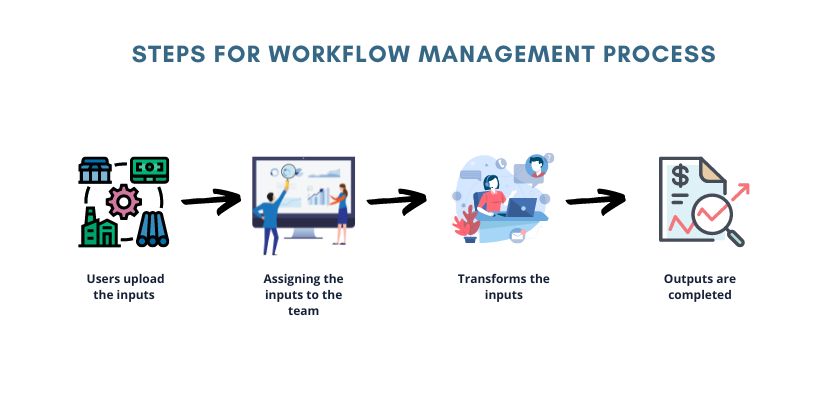Summary- Workflow management is nothing but a sequence of actions and tasks to accomplish an end goal. It is all about streamlining and managing workflows for the best output. The prime focus of the workflow management software is to reduce redundant tasks, streamline task sequences, and make sure about the available resources for task completion.
A workflow management system is a platform that integrates various workflow tools in a single application. The system involves the automation of various processes in a sequence as per the business parameters.
However, the system can easily automate human as well as machine tasks.
So, in simple terms, about what is workflow management software, it is a unified method that streamlines daily business functions for higher efficiency.
The crucial element of the workflow system is a form that includes data and a bunch of tasks to execute all data processing quickly.
For instance, procurement includes workflows for purchase requisition, invoice processing, and POs. These individual workflows are developed with several tasks like approval, creation, review, and more.
Components of Workflow Management Software
There are several workflow components to understand the workflow automation process. Below are the system’s main components that will fetch data to assist users in completing their tasks.
-
Transformation-
These are the specific actions that help get inputs from the next state. This process would mean sending a document to sign off, allowing onboarding tasks to team members, or processing information about a new hire.
-
Outputs-
These are the products of every transformation, including materials required for the following stages. It includes a contact seeking one signature or a box having office hardware. This also has the end result when the workflow is finished.
-
Inputs-
These are the components required to complete a particular task. While making use of the HR onboarding process, this might involve some contract or information about the new hiring person, a document having outline software, equipment, and other office elements as well that are required.
Finally, these primary components can be easily transferred into objects, events, and rules that can make a better flow of the workflow system.
However, they can be easily assembled in various tasks, tracked the completed tasks, and assembled in tasks. Also, they can be quickly taken from basic concepts to actionable or actual work.
Steps for Workflow Management Process
A workflow management process would revolve around these steps-
a. Users upload the inputs
b. Assigning the inputs to the team
c. Transforms the inputs
d. Outputs are completed
Types of Workflow Management Systems
There are a variety of different types of workflow management systems available on the market. The most common are those that are based on graphical representations of the workflow.
Other systems are based on text representations of the workflow. Some systems are based on a combination of the two.
Text-based workflow management systems use a text representation of the workflow. The steps in the process are written out in a text document. This type of system is usually used when the process is too complex to be represented by a flow chart.
Combination workflow management systems use both a graphical representation and a text representation of the workflow. This type of system is useful when there are a lot of steps in the process, and the process is too complex to be represented by a flow chart.
Why is a workflow management system essential for your business?
In most cases, most workers can feel burdened due to the redundant tasks. While in these cases, workflow management software can enhance scalability and customer satisfaction by reducing time-consuming tasks.
Undoubtedly, these systems can improve the scalability of the business while also increasing employee burdens and enhancing customer satisfaction as well. This can be achieved by minimizing tedious tasks and enhancing TAT.
The most significant component of workflow management is the capability to automate tasks as per the available flow.
Below are some prominent reasons why automation can improve workflows-
- Boosting employees to function autonomously by making sure they know what is expected
- Bringing high efficiency throughout workflows while removing bottlenecks to improve outputs and productivity
- Developing alignment through automatic sending updates, deadline alerts, and emails.
- Offering an audit trail and insightful metrics for managers to count the performance
- Streamlining workflows that ensure tasks get completed on time
There are many benefits to using workflow management software. Perhaps the most obvious benefit is that it can help you to be more organized and efficient.
With all your tasks and deadlines in one place, you can easily track what you need to do and when. This can help you to stay on top of your work and avoid stress.
Another benefit of using workflow management software is that it can help you to improve your productivity. By automating specific tasks and setting up automatic reminders, the software can help you to work more efficiently. This can save you time and allow you to get more done in less time.
Workflow management software can also help you to improve your communication and collaboration. With the project management tool, you can share files and collaborate on projects, you can work more effectively with your team. This can help you to achieve your goals faster and more efficiently.
A workflow management software can help businesses by automating and organizing their workflows. This software can help businesses monitor and manage their tasks, projects, and resources.
The workflow management software is designed to help businesses manage their tasks and projects more efficiently. It assures better project management.
It typically includes task prioritization, Gantt charts, and notification systems. This software can be extremely helpful for businesses that need to manage many tasks simultaneously.
Workflow management software can help you streamline your business processes, making you more productive. So if you’re looking for a way to improve your business, consider using workflow management software.
With a workflow management system in place, you can easily see what tasks need to be done and at what stage each task is completed. This can help you to stay on track and avoid overlap in tasks.
A workflow management system can also help you to bring next-level enhancement to your team. By sharing a standard system for tracking tasks, team members can easily see who is working on what and what still needs to be done.
This can help prevent confusion and ensure everyone knows what needs to be done.
By evaluating your needs and carefully researching your options, you can find the perfect system for your business.
<<Also Read: 5 ways to keep ERP Project On-Schedule>>
When is the right time to invest in Workflow Automation?
As we know, each company is unique, and some signs indicate your company requires a better approach through workflow management solutions. However, some of these signs would include the following-
- Recurrent concerns with payroll or scheduling
- Redundant tasks and data entry is manually processed
- Continue cash flows and customer complaints
- Projects are not completed on time, and employees are constantly burdened and overworked out.
- You are working with temporary workers, and your team doesn’t communicate with each other properly.
- The team members constantly depend on spreadsheets and paper-based processes.
Beyond these considerations, you will know it is time to invest in the right workflow management system.
How to select the best Workflow Management system?
When it comes to choosing the apt workflow management system for your business, there are a few factors to consider. The first is what kind of business you have. Workflow management systems are designed for specific industries, like construction or healthcare.
If your business doesn’t fit into one of those categories, there are general workflow management systems that can be adapted to your needs.
The next thing to consider is the size of your business. A small business may not need all the features of an extensive workflow management system. Some systems are tailored for businesses of all sizes.
The last thing to consider is your budget. Workflow management systems can range in price from a few hundred dollars to several thousand dollars. Choose the system that fits your needs and your budget.
Best Practices for Workflow Management System
As you adopt a new workflow management system, you can consider many methods to make things successful. Communicating well with the team members, prioritizing tasks and selecting the best-suited technology for your business would serve as the best practices to deliver tangible results to the company.
Prioritize & set goals
Before spending money or creating complex parameters for every business task, it’s pretty crucial to think of the highest priority tasks of the companies. You can collect stakeholders and discuss what innovation can be done and what are the biggest frustrations of the company employees.
You could also discuss more common workflows and any loopholes and then select the best solution around it.
Note down your present workflows
The primary aim of planning throughout the teams is to vanish time-consuming and redundant tasks. You can, however, do this by analyzing the functions to check issues regarding the current workflows.
Let each of the stakeholder sketch the flowchart of these things they often do while also taking note of disturbing stages.
It is recommended that you should analyse and study how one person would explain the daily operations to a new person without any knowledge of completing the task.
Usually, workflows are more easily understood when they are shown in visual presentation. Once your sketch for the workflow is done, you must generate some supporting documentation.
The main aim should always be to elaborate tasks, workflow management tool, and members included in the workflow system. The most specific thing is significantly easier to optimize and implement a procedure that is repeatable.
<<Also Read: Top ERP Trends in 2022>>
Understand every team’s automation requirements
Some workflow management practices would be very particular to the organization’s common types. A few of them are for finance, facilities, operations, and other teams as well.
Procurement & Finance workflow practises-
- Streamlining and automating the execution
- Increasing end-of-month close tasks
- Tracking & creating financial requests
Operations Workflow
The operations team utilize a workflow management system to enhance flexibility while also increasing compliance to a greater extent.
- Create dashboards that can fetch key in real-time data from varied processes to optimize and measure the KPIs.
- Generate personalized automated workflows through low-code and no-code to leverage companies’ specific needs
- Easily integrate CRM, ERP, and HRIS systems with workflow management solutions to enhance company efficiency.
Workflows Recruitment
Recruiting needs its own set of repeatable workflows, and the workflow management assists here-
- Communicate through various departments more effectively to develop only well-qualified candidates who can easily crack through the interview
- Eradicate engaged workflow by automating scheduling interviews, posting feedback, and taking approvals from hiring managers.
- Manage resumes for best-fit candidates and can recall them whenever there are new positions available.
Sage Software Solutions is a leading IT company with an array of advanced ERP Software solutions. Our proprietary products — Sage X3 and Sage 300 will help you cut your operational expenses, improve business productivity, increase operational efficiency, forge robust customer relationships, and strengthen association with vendors, suppliers, and distributors. So, if you are looking to reinforce your business fundamentals and emerge as an industry leader, then please schedule a call with one of our sales representatives.






